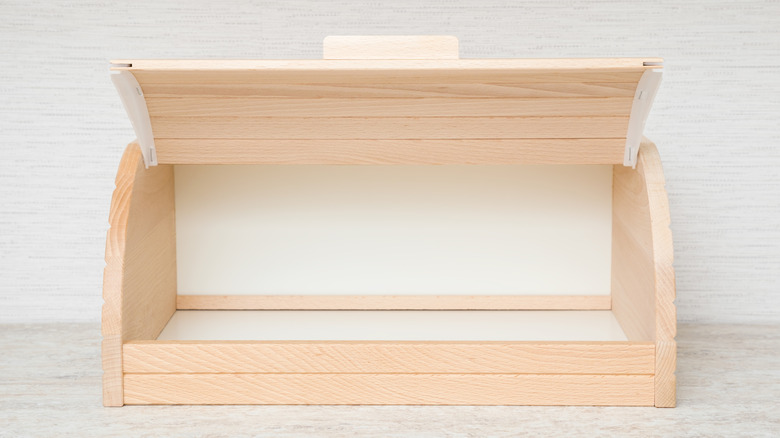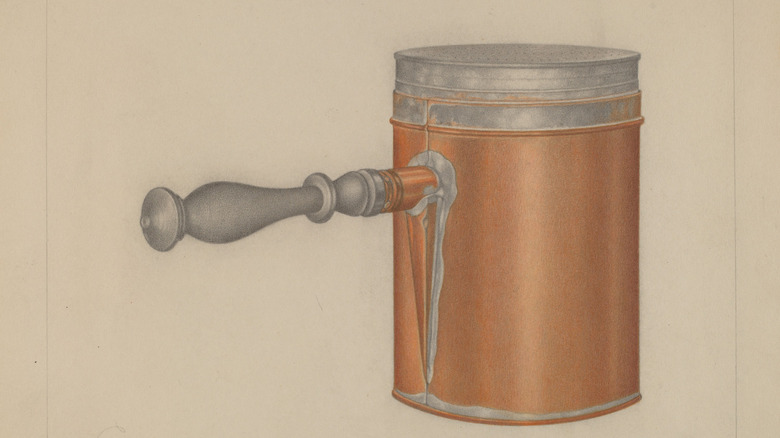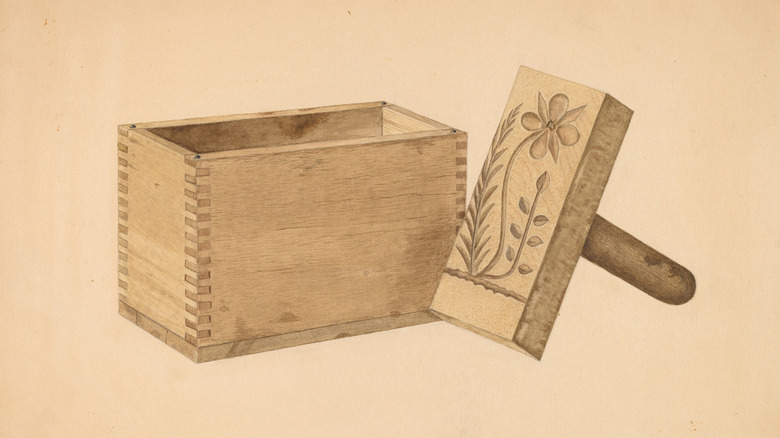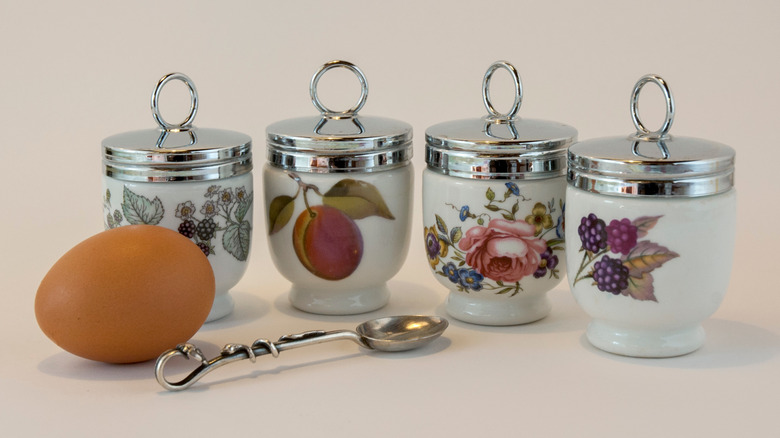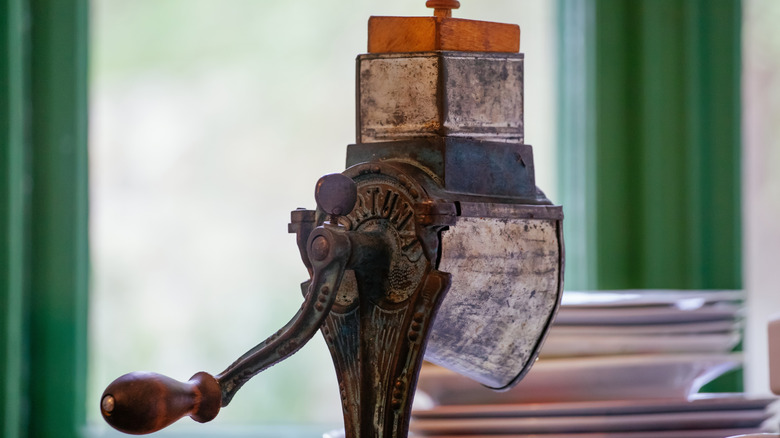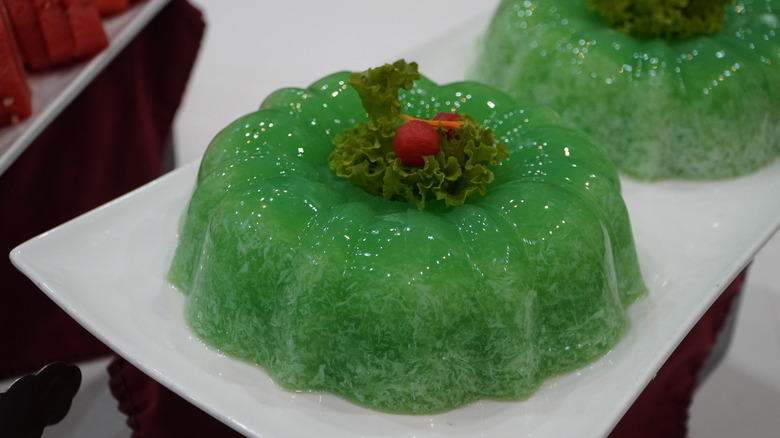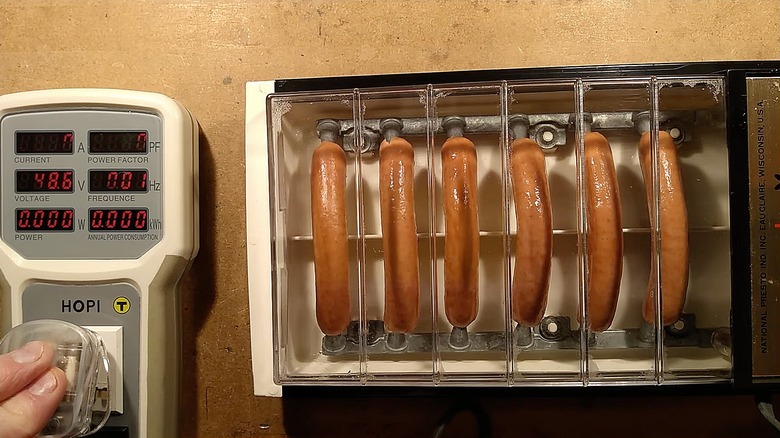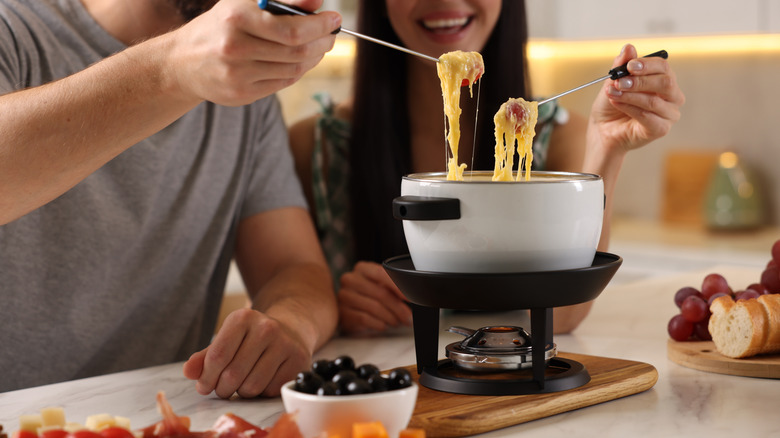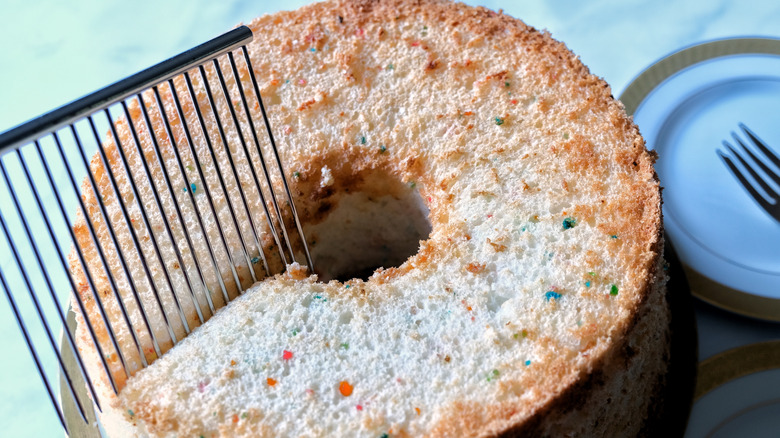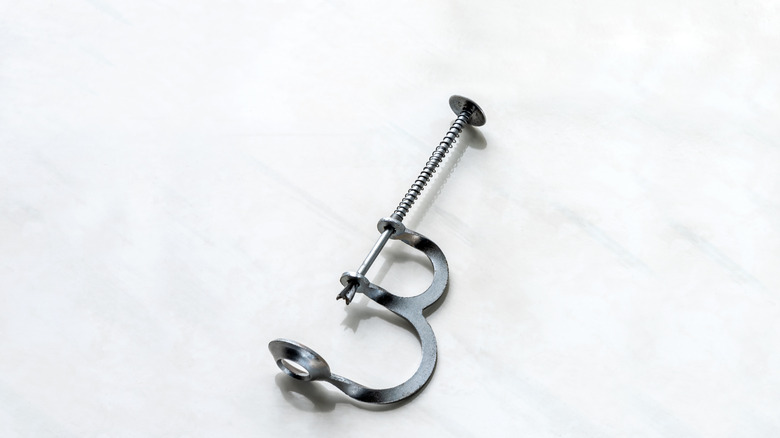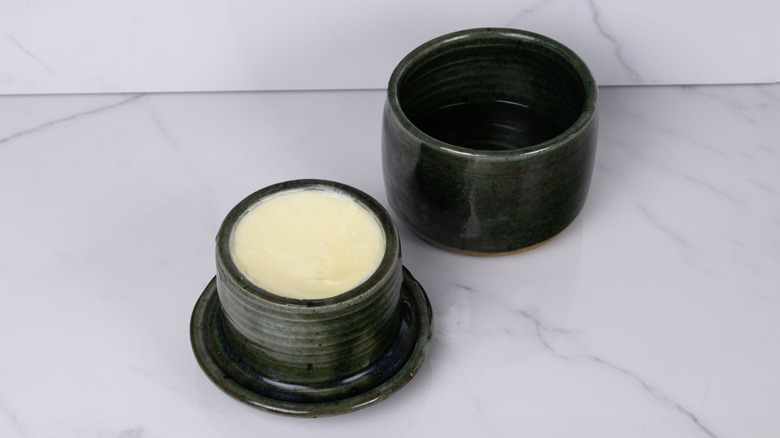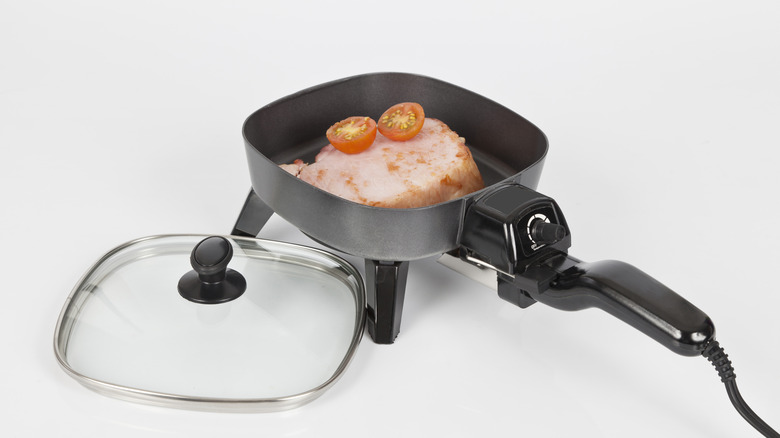16 Old-School Kitchen Items Nobody Uses Anymore
Culinary tools are always advancing, and the technology we use to cook is leagues ahead of where it was just 20 years ago. But have you ever wondered what happened to those old-fashioned kitchen items that we used to rely on so much? There are so many popular vintage cooking tools that were once commonplace in kitchens across the country, but today, they've practically disappeared from households everywhere.
Some of these tools, like the beloved hot air popcorn popper, only had their heyday for a couple of decades. But what happened to items like the egg coddler, which remained a household staple for centuries, only to practically disappear overnight? Let's take a brief dive into the history behind 16 once-popular vintage cooking tools that nobody seems to own anymore.
Breadboxes
The humble breadbox helped keep fresh-baked loaves soft long before sliced bread was around. Breadboxes can be traced back to the 1800s, though they weren't patented until 1918. Breadboxes soon became a household staple because they helped keep bread fresher for longer by protecting it from air and moisture. They were also helpful for shielding loaves from kitchen pests, like mice.
Eventually, fresh-baked loaves fell out of popularity in favor of pre-sliced bread, which was full of preservatives, meaning it could be kept out on the counter (or simply in a plastic bag) for longer. But just because the bread box has fallen out of fashion doesn't mean it's totally useless. Sure, a breadbox can help you declutter your countertops – but anyone who picked up a sourdough hobby back in 2020 might consider getting one to use for its original purpose. It can help you keep your homemade loaves fresher than a plastic bag would, and it adds a great vintage touch to any kitchen. If you happen to have an old one lying around, you can also repurpose your breadbox as a stylish organizational tool.
Hand-crank flour sifters
Flour sifters were popular in the late 1800s for easily removing lumps from flour. A hand crank would allow the user to sift the flour through the machine, which meant that any chunks would never make it into the mixing bowl. Flour sifters were prized for their speed, with many vintage advertisements touting how quickly a baker could sift through a tin of flour. The sifters also helped bakers to sift flour without any mess; the machines would deposit the flour directly into the bowl below.
A baker using a flour sifter would often find that their baked goods turned out fluffier, lighter, and softer than they would have otherwise. Of course, home cooks now can simply aerate their flour by sifting it through a strainer. This might not be as quick as an old-fashioned flour sifter, but at least it's one less tool you have to consider when you're decluttering your kitchen.
Butter molds
Have you ever felt like your butter just isn't fancy enough? That's not a common modern-day problem, but for 18th-century farmers, the looks of their butter was actually something they had to consider. The butter mold was first popularized by farmers who wanted to sell their butter; they would use a butter mold to imprint their products with unique, recognizable designs. This would serve to attract customers and ensure that previous buyers remembered who they'd purchased butter from.
There are many different types of butter molds. Some would be wooden stamps, which would be pressed onto the butter to form a design. Others would have a design on a roller, which would be rolled across the butter to leave an impression. Besides being popular with farmers, butter molds were often a vintage kitchen staple just because it made your butter look pretty. Households would rely on their butter mold to make butter look more suitable for the dinner table. Common designs included various types of flowers, as well as pineapples, a common decorative motif of the period.
Hand-crank mixers
The hand-crank mixer first came about in the 1850s, and it was absolutely revolutionary. Imagine being confined to mixing liquids, eggs, and batters by hand, and then suddenly being presented with a quality crank that could meringue egg whites with ease. Not as much ease as an electric mixer, of course, but they were still decades away from that invention.
The initial hand-crank mixer design was intended primarily for eggs, and it featured a whisk attached to a small crank which could be held in one hand and spun around to easily whip up egg whites. Making meringue out of eggs was a time-consuming task when done by hand, so this was quite the invention for home cooks and restaurant kitchens alike. Hand mixers were also commonly used to mix up other baked goods, at least until the electric mixer took over in 1885. In fact, the invention of the electric mixer is why you don't see hand mixers in most modern kitchens. We have to admit that letting a machine do the work of whipping frosting and kneading dough is much more appealing than cranking a hand-held mixer.
Egg coddlers
Egg coddlers are teeny little dishes that are the perfect size for a single egg. Crack an egg open and drop it inside the coddler before replacing the coddler's lid. Then, pop the entire thing into a pot of water so it stands up — egg coddlers are never entirely submerged, so the coddler won't get water inside of it. The result is a perfectly soft egg, much like the result you'd get from poaching one.
Coddled eggs were popular for decades, primarily across Europe. The UK in particular took a special liking to the dish, and some of the most intricate egg coddlers were designed by Royal Worcester, which first began producing coddlers in the 1880s. They may not be one of the vintage kitchen items that are worth a fortune today, but they're works of art nonetheless. Despite their usefulness, modern kitchens remain devastatingly coddler-less. They began to fall out of fashion as modern priorities took over; simple, on-the-go breakfasts took prevalence over fancier methods. Now, the average home cook remains sadly unaware of the egg coddler, a single-use culinary tool that isn't as popular as more versatile egg-cooking methods.
Nut grinders
The elegant hand-crank nut grinder was a must for easily chopping up nuts to cook with at home. With most models, whole, shelled nuts were placed in the bottom of the grinder — they could be stored there until it was time to grind them up. Simply turn the machine upside-down to force the nuts into the grinder, crank the handle, and ta-da! Finely-ground nuts appear, neatly stored in the cap of the grinder.Older versions of the nut grinder would simply have a box at the top where nuts could be placed. Crank the handle, and ground nuts would come out of the side of the machine via a funnel.
So, why did the nut grinder disappear from modern kitchens? Over time, food processors and blenders took over the job, making the old hand-crank nut grinder more of a nostalgic relic than an everyday tool. Even easier — you could just buy finely-chopped nuts at the store.
Gelatin molds
There are all sorts of horrifying gelatin recipes that came about in the early 1900s. But gelatin salads didn't just spawn out of nowhere. Besides being useful for your garden, gelatin used to be a sign of wealth — gelatin dishes can be traced back to medieval Europe, and remained popular throughout the 1800s. Making gelatin without modern-day boxes of Jell-O or agar agar powder was incredibly difficult and resource-intensive, so having dishes made out of gelatin at your royal table was one of the best ways to flex your wealth to your guests at the time.
Skip ahead to the 1900s, and Jell-O finds a way to make gelatin available to households all across America, for a very affordable price. All of a sudden, cooks across the country are realizing that they, too, can eat like a royal by stuffing their Jell-O full of olives, tuna salad, and shrimp. Of course, these stomach-turning Jell-O recipes required beautiful molds, so that your gelatin dish could look just as elaborate as the royals' used to be. Gelatin molds remained a staple in households all the way up until Jell-O meals fell in popularity in the 1970s. Gelatin molds used to be quite the sight, though; whether shaped like a loaf, a Jel-Ring mold (the classic circular design with a ring in the center), or novelty shapes...like lobsters.
Hot dog cookers
The iconic Hot Dogger by Presto designed what is essentially a hot dog torture device. Stick several hot dogs onto skewers laid flat across the Hot Dogger, pop the cover on. You can then cook your hot dogs "from the inside out," according to one of Presto's advertisements for the device.
Those poor hot dogs fare much better in modern day, since most people tend to grill their hot dogs or just pop them in the oven for a while to cook them. This is partly due to single-use gadgets like the Hot Dogger falling out of style over time, but the Hot Dogger eventually had to face the music: the device often caused hot dogs to burn or fall apart as they cooked, which made it difficult to use properly.
Fondue pots
All the way back in 18th-century Switzerland, a major culinary milestone had just been achieved: the invention of fondue. The dish took its sweet time to become popular, however; it didn't gain celebrity status until the 1930s. But we're here to talk about the vessel behind fondue: the fondue pot. It became enormously popular in the US in the 1960s. Special fondue sets were sold to help cooks across the nation enjoy fondue for themselves.
Sets usually consisted of a ceramic pot, often with a matching stand and tray to hold the pot over a candle, which kept the cheese warm and melted. You might have also seen fondue sets being sold with adorable metal fondue skewers and matching serving bowls to hold anything you'd want to dip into the fondue. While fondue is still plenty popular today, it's more commonplace to see fondue being served in a regular pot than in a full fondue set. We think fondue sets might be making a comeback, however.
Hot-air popcorn poppers
Hot-air popcorn poppers are one of the more recent items on this list, as some households do still rely on them today. But you won't see this device in most modern kitchens. It only came about in the 1970s, and it was actually created after the invention of microwave popcorn. However, at the time, a hot-air popcorn popper was more accessible than a microwave, which meant that it was a convenient staple for households who wanted fresh popcorn for at-home movie nights.
Insert your popcorn kernels into the base of your hot-air popcorn popper, and then turn the unit on. It blasts hot air until the kernels are encouraged to pop, at which point jump up and push each other out of the top of the machine and into a bowl waiting below. Over time, microwave popcorn took over from the hot-air popcorn popper, especially now that microwaves are commonplace in most modern kitchens. If you're feeling inspired by the hot-air popper, however, you can certainly still purchase a more modernized one today.
Cake breakers
If you've ever struggled with cutting a soft and airy cake — like angel food cake — then this gadget is for you. A typical knife will awkwardly compress a fluffy cake as it cuts, making it difficult to slice. But a cake breaker isn't solid; instead, it's comprised of many thin prongs, with a bit of space between each one. Use it as you would a regular knife by pointing the prongs into the cake and cutting out a piece.
The cake breaker was first patented in 1932. Though the device was designed specifically for angel food cakes, you can certainly use it to cut smoothly through any kind of cake you wish. Rather than crumble under the pressure, the thin and delicate prongs will encourage even the fluffiest of cakes to remain perfect when cut.
Cherry pitters
There are many different types of vintage cherry pitters, and all of them are equally interesting, but the spring-loaded cherry pitter is one of the closer predecessors to the modern cherry pitter. Pitting cherries was no easy task prior to the invention of what is now the modern cherry pitter, so baking up a cherry pie was thrice the hassle that it is today. Spring-loaded cherry pitters were made out of metal, with a spring at the top of the device and a small tray with a hole in the center for holding the cherry in place underneath. Pull the spring up, pop the cherry inside, and push the spring back down; the pit would pop out of the cherry and through the hole at the bottom of the device.
Early versions of cherry pitters were often made of cast iron or tin and looked more like miniature presses than the sleek gadgets we use today. You won't see these types of cherry pitters around because they just aren't easy enough to use, especially compared to a modern cherry pitter. But spring-loaded cherry pitters certainly are fun!
Recipe cards
As much as we love recipe cards, we have to admit that they're not a common kitchen staple nowadays. Recipe cards (and recipe card boxes) used to be a must-have. You could write down your own original recipes on cards that were easy to pull out and reference in the kitchen. Recipe cards were also fantastic for sharing, and you might find many favorite vintage recipes today taken straight from the card they were initially written on.
It's no secret why recipe cards aren't used today. Rather than searching through a recipe card box for your favorite meal, you're probably looking through your saved Instagram videos or looking up the best way to bake a cake. If you still treasure your old family recipes, however, then you might want to try honoring your recipe cards with rustic decor you can find at the thrift store — one of many handy ways to incorporate these culinary heirlooms into your home's decor.
Butter bells
Butter bells are an interesting invention from long before we were able to store our butter safely in the fridge. The butter bell was first invented in France in the 1800s, and was a genius way to keep butter fresh at room temperature. A butter bell has two parts: the bowl (or bell) shaped lid, and the container that the lid fits into. Cram and press your butter into the lid of your butter bell until it's completely full. Then, fill the outside container with cold water, and put the bell into the water.
All together, this will create a lovely airtight seal for your butter to live inside. This means that your butter won't go bad when kept at room temperature — it usually lasts about a month inside the bell — but it also allows you to always have access to room-temperature butter that's perfect for spreading straight out of the bell. The only downside is that you'll have to change your butter's water out at least once a day. Naturally, refrigeration eventually won out over the butter bell — but some bakers still swear by the butter bell today.
Electric skillets
The electric skillet was an especially useful device back when modern stovetops didn't exist. If you were sick and tired of how long your stove took to heat up — in the era of convenience, no less! — then you might have turned to the electric skillet. There were many different versions of this incredible device — some came with lids and were designed to be the perfect frypan, while others were more of a basic cooking pan style. Plug in the handle, turn the knob to the temperature you want, and you can cook up breakfast without ever touching the pan to the stove.
As modern cooktops became faster, stronger, and more convenient, the electric skillet naturally fell to the wayside. However, we can't deny that it certainly is fast and helpful — which is probably why more technologically-advanced, modern versions of the vintage electric skillet have started popping up again. In its heyday, the electric skillet was a countertop staple, prized for keeping an even temperature and freeing up precious stove space during big family meals.
Hand-crank apple peelers
When you think about peeling apples nowadays, you probably picture a simple handheld peeler that makes quick work of an apple's skin. However, there used to be entire machines dedicated to slowly peeling away at the skin of a single apple (or potato), though they're much less commonplace today. Vintage hand-crack apple peelers would typically come with a clamp that would attach the machine to a table or countertop. Tighten the clamp and attach your apple to the skewers on one end of the device. Crank the handle, and the machine will methodically spin the apple around, peeling it as it does so.
Unlike modern handheld peelers, these clamp apple peelers typically took off more of the apple than was necessary. Today, most people just don't have the space in their kitchens for a huge device that is exclusive to apples and potatoes. Still, these vintage machines certainly do look great if you're into making apple cider.

